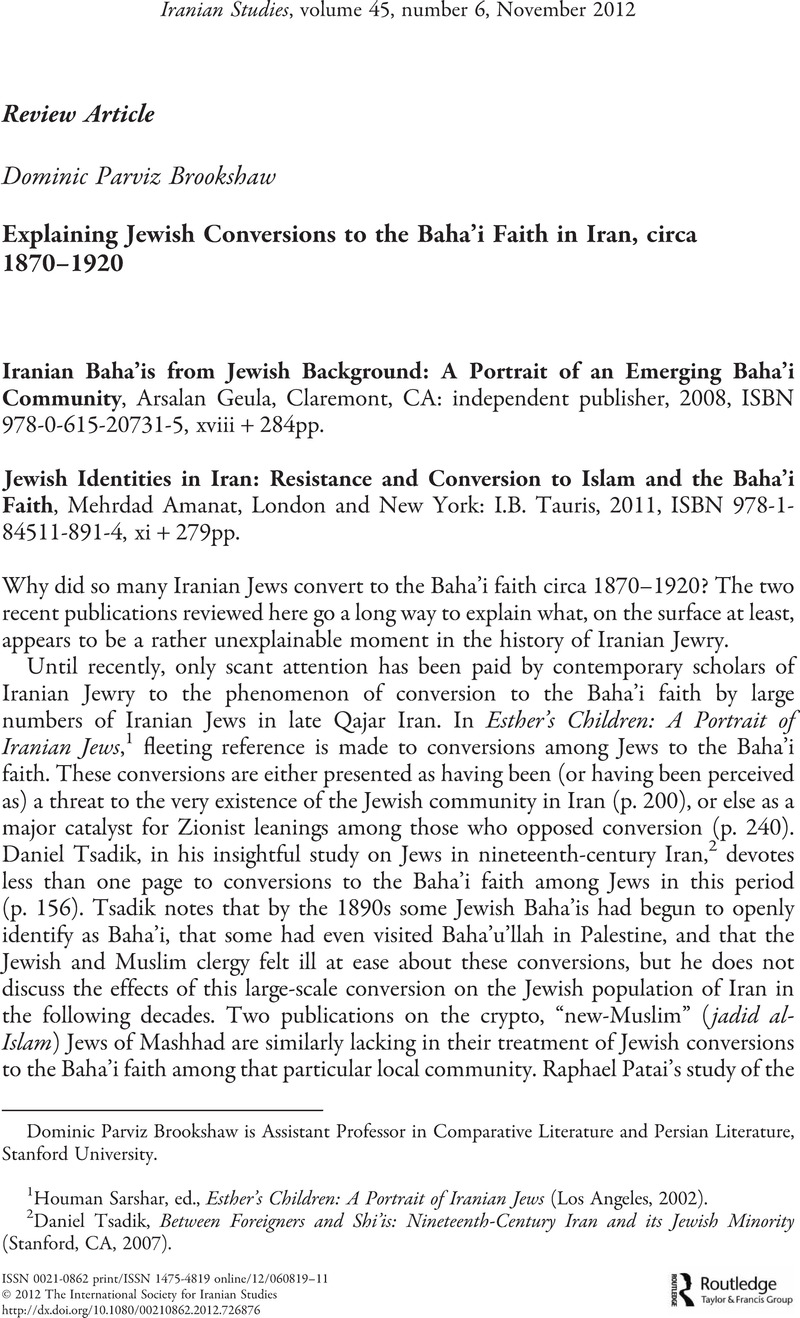No CrossRef data available.
Published online by Cambridge University Press: 01 January 2022

1 Sarshar, Houman, ed., Esther's Children: A Portrait of Iranian Jews (Los Angeles, 2002)Google Scholar.
2 Tsadik, Daniel, Between Foreigners and Shi'is: Nineteenth-Century Iran and its Jewish Minority (Stanford, CA, 2007)Google Scholar.
3 Patai, Raphael, Jadid al-Islam: The Jewish New-Muslims of Meshhed (Detroit, 1997)Google Scholar.
4 Nissimi, Hilda, The Crypto-Jewish Mashhadis: The Shaping of Religious and Communal Identity in their Journey from Iran to New York (Brighton and Portland, 2007)Google Scholar.
5 For an alternative, more detailed discussion of anusim converts to the Baha'i faith and their impact on the Baha'i communities of northeastern Iran, Central Asia and Russia, see Fu'adi-Bushru'i, Hasan, Tarikh-i diyanat-i Baha'i dar Khurasan, ed. Foadi, M. and Vahman, F. (Darmstadt, 2009), 179–87Google Scholar.
6 Maneck, Susan S., “The Conversion of Religious Minorities to the Baha'i Faith in Iran: Some Preliminary Observations,” Journal of Baha'i Studies, 3, no. 3 (1991): 35–48CrossRefGoogle Scholar.
7 Houman Sarshar, “Hamadan viii. Jewish Community,” Encyclopaedia Iranica XII: 615–623. Although his discussion of possible motivations behind the conversion of large numbers of Hamadan's Jews to the Baha'i faith in the late nineteenth century is brief, Sarshar does pose some thought-provoking hypotheses, a number of which are developed by Amanat in his book. On the fact that the Baha'i religion was of greater appeal to Jews than Christianity in this period, Sarshar argues (“Hamadan viii. Jewish Community,” 618), “One possible hypothesis for this dynamic could be the fact that Bahaism offered itself as a sort of ideological melting-pot indigenous to Persia,” he continues, “A Jewish convert could thus fit into this new religion by ‘melting’ into a more inclusive and comprehensive religious ideology without having to give up his/her identity as a Persian. Bahaism thus offered the hope of assimilation to a severely marginalized subculture, without threatening to strip the converts of their more primary socio-cultural identity and ideological heritage.”
8 Amanat, Mehrdad, “Messianic Expectations and Evolving Identities: The Conversion of Iranian Jews to the Baha'i Faith,” in The Baha'is of Iran: Socio-historical studies, ed. Brookshaw, Dominic Parviz and Fazel, Seena B. (London and New York, 2008), 6–29Google Scholar. A recent book in Persian also plots the conversion of Jews to the Baha'i Faith in Hamadan and includes a good number of the tablets addressed to Jewish Baha'i converts by Baha'u'llah and ‘Abdu'l-Baha, see Sabeti, Habibullah, Varithan-i Kalim: Tarikh-i Hayat u Khadamat-i Ahibba-yi Kalimi-yi Hamadan (Bundoora, Australia, 2004)Google Scholar.
9 For an analysis of some tablets to Jewish Baha'i women in Hamadan, see Brookshaw, Dominic Parviz, “Instructive Encouragement: Tablets of Baha'u’llah and ‘Abdu'l-Baha to Baha'i women in Iran and India,” in The Baha'is of Iran: Socio-historical Studies, ed. Brookshaw, Dominic Parviz and Fazel, Seena B. (London and New York, 2008), 63–65Google Scholar.
10 For an analysis of the intersection of the interests of the clergy, state, and mob in violent attacks on Babis and Baha'is, see Amanat, Abbas, “The Historical Roots of the Persecution of Babis and Baha'is,” in The Baha'is of Iran: Socio-historical Studies, ed. Brookshaw, Dominic Parviz and Fazel, Seena B. (London and New York, 2008), 170–83Google Scholar.
11 For details on Baha'i public health efforts, in particular the construction of hammams and hospitals (in which Jewish Baha'i converts played a leading role), see Fazel, Seena B. and Foadi, Minou, “Baha'i Health Initiatives in Iran: a Preliminary Survey,” in The Baha'is of Iran: Socio-historical Studies, ed. Brookshaw, Dominic Parviz and Fazel, Seena B. (London and New York, 2008), 122–40Google Scholar.
12 The most comprehensive study of the Baha'i contribution to modern education in Iran (which provides detailed information on the Baha'i-run schools in Hamadan and Kashan) is that of Shahvar, Soli, The Forgotten Schools: The Baha'is and Modern Education in Iran, 1899–1933 (London and New York, 2009)CrossRefGoogle Scholar.